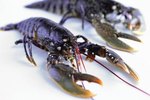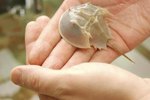
The phylum of mollusks includes more than 50,000 known species, found in freshwater and marine environments as well as on land. Snails are some of the best known terrestrial members of a group that also includes clams and mussels. Echinoderms, in contrast, live exclusively in marine environments. At least 6,000 species comprise the phylum Echinodermata, the largest without any freshwater or terrestrial animals. Famous echinoderms include sea stars and sea urchins.
These Feet Were Made for Walking
Echinoderms have a water vascular system originally used to collect and transport food to their mouths. The creatures evolved to use this system for movement as well, and "walk" by expanding or contracting their rows of tube feet in a particular sequence. In contrast, most mollusks have a single muscular foot they use to walk. The many mollusk species are incredibly diverse, however, and some mollusks such as oysters have no foot at all. Oysters and other bivalves force a jet of water out of their shells to shoot themselves through the water. Cephalopods such as squid move using jet propulsion, although their arms or tentacles are derivatives of the mollusk foot. Some octopods can use their arms to walk.
Finding the Center
Most creatures are bilaterally symmetrical, but echinoderms are the exception to this rule. These creatures are radially symmetrical, meaning all their appendages emanate outward from a central point. Most echinoderms have five appendages, although their are some exceptions. Sea stars have perhaps the most visually obvious radial symmetry. Echinoderms begin life as bilaterally symmetrical, plankton-like larvae, but as they mature their body shape changes. Most mollusks, on the other hand, exhibit bilateral symmetry. Gastropods begin life with bilateral symmetry, but through a process called "torsion" their bodies twist in their shells as they develop. As a result, mature gastropods are asymmetrical.
Shelling It Out

Mollusks have soft bodies, and most secrete a shell to protect it. Around 70 percent of all mollusks are classified as gastropods, all of which have shells. Gastropods include snails, and many species live on land. With the exception of nautiluses, cephalopods don't have shells -- but they do have a mantle, the organ that would secrete the shell. Echinoderms don't have shells, but they have other means of protection. Their name comes from the Greek words for "spiny skin," and many echinoderms such as sea urchins have long spines growing from their bodies.
A Matter of Perception
Echinoderms have a non-centralized nervous system and light-sensitive organs at the tips of their appendages that allow them to detect the presence or absence of light. Putting together the information from several of these "eye spots" they can figure out the direction of the light, but they don't have eyes and can't see. Mollusks' heads contain their sensory organs and their brains, with a centralized system more advanced than echinoderms. They do have primitive eyes, although, with the exception of cephalopods, they don't see much more than echinoderms do. Cephalopods have complex brains and the most well-developed nervous systems and eyes of any invertebrate.
References
- University of Michigan Museum of Zoology: Animal Diversity Web: Echinodermata
- Oceanic Research Group: The Wonders of the Seas -- Echinoderms
- Oceanic Research Group: The Wonders of the Seas -- Mollusks
- University of California Museum of Paleontology: The Mollusca
- University of Michigan Museum of Zoology: Animal Diversity Web: Gastropoda
- University of Michigan Museum of Zoology: Animal Diversity Web: Cephalopoda
Photo Credits
-
Jupiterimages/Photos.com/Getty Images
Writer Bio
Jennifer Mueller began writing and editing professionally in 1995, when she became sports editor of her university's newspaper while also writing a bi-monthly general interest column for an independent tourist publication. Mueller holds a Bachelor of Arts in political science from the University of North Carolina at Asheville and a Juris Doctor from Indiana University Maurer School of Law.




